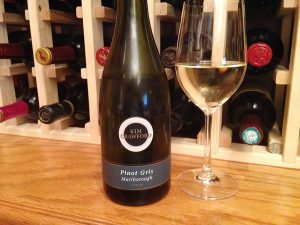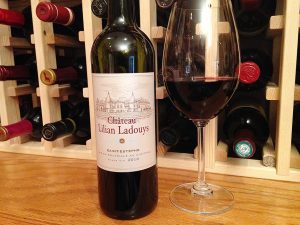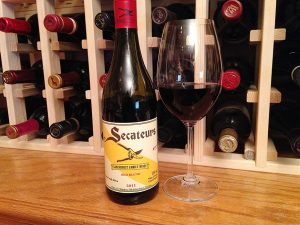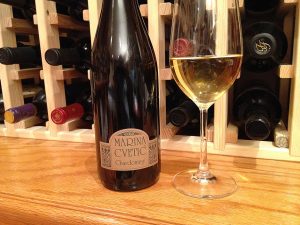Kim Crawford Pinot Gris Marlborough 2014: Pale gold color; delicate nose; delivers with good fruit on the palate, peach, apple, pear, melon, honey; clean, bright pleaser, good acidity. Kim Crawford and his wife, Erica, have been meteoric trailblazers in New Zealand wines since the late 1990s, charging onto the world wine stage in the 2000s with year-after-year 90-point scores from the various panjandrums of wine scores. While KC is most noted for superb sauvignon blanc, this pinot gris has delightful fruit-forward sweetness with blade of New Zealand grass and expected food-friendly, palate-cleansing acidity. Refreshing, easy drinking, appropriate price. $16
Author: Gus Clemens
Château Lilian Ladouys Saint-Estèphe 2010
Château Lilian Ladouys Saint-Estèphe 2010: Inky ruby-black; red fruits take time to open for the nose, then reward; muscularly flaunts power of cab-driven Saint-Estèphe with full, puckery tannin, rich blackberry, black currant, oak, smoky toast, earth on the palate. Some Saint-Estèphe are suave and reserved (usually merlot-driven), this immediately lets you know you have a robustly serious Bordeaux in your mouth—60% cab, 40% merlot. Full body; swirl-a-lot or decant-an-hour-plus to bring out its best. Saint-Estèphe is the northmost of the six communal appellations of Médoc. Serious, impressive, big-boy pour; not made for faint-of-palate newbies, but seasoned sippers will enjoy a fling with Lilian Ladouys. $35
Badenhorst Secateurs Red Blend Coastal Region 2011
Badenhorst Secateurs Red Blend Coastal Region 2011: Inky color, pepper, smoke nose; big cherry, raspberry, plum, redcurrant tang, some white pepper and restrained oak on the palate; shiraz (64%), cinsault (26%), grenache, mourvèdre, pinotage (grapes and percentages vary with vintage); complex and well-done, supple tannin, easy drinker, easy finish. Adi Badenhorst is one of the new giants in South African winemaking, pushing Swartland region onto the world stage with his charisma, beefy rugby player body, pork chop sideburns, freewheeling conversational style, and passion for quality wine at reasonable prices. Ari asks the fruit to speak, so counterintuitively this is not bulldoze you over booze bomb, but comes in at restrained 13.5% alcohol. Most people know of the Stellenbosch and Paarl wine regions in South Africa; Swartland (30 miles north of Cape Town) is a new frontier of wine and olive production. Get a flavor of the spirit of the region and winemakers by visiting http://aabadenhorst.com and checking out their “The Swartland Revolution” poster where Adi is dressed up somewhat like Mr. T surrounded by toughs in leather and an easy-on-the-eyes lass while bombs explode and helicopters and missiles fly in the background. They may talk bad boy, but boy they make good wine. $19
Wine issues
Open enough wine bottles and you will encounter things you aren’t sure about. What do you do?
Things you don’t have to worry about and are not flaws: Continue reading “Wine issues”
High summer sippers
High summer’s go-to wines: rosé, vinho verde, prosecco.
We visited rosé last week. Vinho verde is delicious, delicate, light wine from northern Portugal you should try.
Prosecco sometimes is called poor person’s Champagne, but that does disservice to sparkling wine that is made in Italy’s Veneto region and tastes great in a plastic cup by the pool. Continue reading “High summer sippers”
July 4th
Fourth of July wine suggestions are fraught with patriotic paradox and peril.
Patriotic call: California zinfandel, quintessential American wine. But zin is bold, fruity, high alcohol; drink early in heat and you pass out before firework’s rocket red glare. Not cool, dude. Continue reading “July 4th”
Acidity
Acidity is vital for vino.
When acidity is too low, wine is dull and flat. When acidity is too high, wine is tart and sour.
When acidity is just right, wine is a palate-cleansing food friend, a delicious delight.
Wine acidity sweet spot is between 3 and 4 pH. Most wines land between 3.3 and 3.8. Whites tend to be more acidic than reds. For comparison, milk is around 6.6 and lemonade 2.5
Once upon a time, wine wonks imagined they could spin any grape into gold, but that hubristic notion proved wrong. To make good wine, you must start with a good grape farmer.
A good grape farmer starts with good soil and an obliging climate.
Warm climates produce wonderfully fruity, sweet grapes. But warm throttles acidity.
Cool climates produce wonderfully acidic wines. But cool throttles sweet fruitiness.
There are places where climate embraces wine’s vines—warm days, cool nights—and, guess what, that’s where world’s great wines are made. Something to remember next time you buy a bottle.
Chardonnay is classic example of role played by land and climate (“terroir”). French chablis is chardonnay produced in cool climate; winemakers know how to make a flinty, food-friendly wine. Chablis is so acidic, it typically requires malolactic fermentation—a process that turns malic acid into softer, buttery flavors. Chaptalization—adding sugar—is permitted. Adding acetic acid is not.
California chardonnays fight for acidity in warm, fruit-friendly climate. Californians cannot add sugar to increase sugar levels; no problem, they don’t have to. Adding acid—allowed.
Both places produce charming, different chardonnays. Such is wine’s refulgent wonder.
Tasting notes:
• Dark Horse Chardonnay 2013: Pear, peach, apple, butterscotch, caramel, on-lees aging adds nutty flavor; oak not over-the-top; good acidity; easy drinking value with fillip of flair; sip cool by pool. $10
• Mirassou Pinot Grigio 2013: Crisp acidity; citrus, orange zest, pear, peach; soft mouth; delicious, sweet ripe-fruit freshness. $12
• Frei Brothers Russian River Valley Reserve Chardonnay 2013: Polished exemplar of Russian River chard; green apple, honeysuckle, melon, pineapple; cool climate vineyard delivers superb acidity to crisply complement food; graceful easy drinker. $20
Last round: Wine is greatest human invention. Yes, wheel is impressive, but it does not go nearly as well with pizza.
Email Gus at wine@cwadv.com. Follow tasting notes on Twitter @gusclemens. Website: gusclemens.com. Facebook: Gus Clemens on Wine.
Father’s Day
In eighth year of this column, coming up with something new for Father’s Day put me over a barrel trying to roll out something fresh.
Then—inspiration. What DIY dad wouldn’t want to know how a cooper makes a wine barrel?
• Wine barrels are made from straight-grain strips of oak so wood doesn’t break when bent. Staves must be cut perfectly, then aged to remove harsh tannins.
• Staves are rounded on the outside and shaved on the inside, which helps in bending. Staves are wider in the middle than on the ends to achieve the bowed barrel shape.
• Barrels are assembled—typical barrel requires 25 to 30 staves—and a metal hoop is placed on one end. At this stage, the barrel looks like a flared skirt topped with a metal belt.
• Barrel is put upright, drenched with water, and a fire is lit inside. Heat and humidity allow staves to be bent by a large vice, slowly pulling staves together at the flared end. Because of careful shaving of the staves, the distinctive bulge forms in the middle as the staves are squeezed together. Metal hoops are hammered home as barrel forms.
• The cooper next starts a fire inside the barrel on the wood to “toast” the interior. Toasting affects the final wine flavor, so this is particularly artisanal element of the effort.
• The cooper cuts a groove inside the top and bottom of the barrel to receive end pieces. Hoops are relaxed to allow the barrel to expand and receive the end pieces. Barrel is squeezed together and hoops re-applied.
• Finally, strips of straw are wedged into any tiny cracks, the barrel is sanded to achieve a finished look, and hoops used in making are replaced by showier finishing hoops.
Wine barrels are different than whiskey barrels. Whiskey barrels are utilitarian holding vessels for four-plus years. Wine barrels hold wine for nine months to two-plus years and are displayed. As one cooper puts it, “a whiskey barrel is a vat, a wine barrel is furniture.” American oak barrels cost $350-$600; French oak barrels $800-$4,000; standard barrels hold 59-60 gallons.
Last round: Father’s Day toast—May you live to be so old your best vintage wine is past its prime.
Email Gus at wine@cwadv.com. Follow tasting notes on Twitter @gusclemens. Website: gusclemens.com. Facebook: Gus Clemens on Wine.
Snobbery
Snobbery is pernicious peril for wine drinkers.
Each person’s palate is different. Pickles may repel you. Asparagus is awful, broccoli beautiful, raw broccoli exceptional, cooked broccoli disgusting. Everyone is keen for green kale, but I have no idea why anyone would ever touch purple kale.
So it goes with wine.
“Sophisticated” wine drinkers eventually wander into tasting territories where furiously exotic flavors flourish. Teeth-purpling reds with flamboyant tannins inflame wine lust. Scouring acidity sends us into paroxysms of pleasure when paired with wild-caught fish served with purple kale.
The rest of the world wishes for a simple, affordable bottle to enjoy with their meal and/or move past a day surviving idiot drivers, bothersome bosses, clueless clients.
If your palate permits you to explore subtle nuances of right and left bank Bordeaux, bravo for you.
If your palate prefers sweet and simple and affordable, something that doesn’t taste much different than cola but has welcomed additional kick, good for you, too.
Best wine is wine you enjoy. Don’t listen when pompous pettifoggers pontificate.
Tasting notes:
• Gallo Family Vineyards Pink Moscato NV: Bright, light-bodied, perky, sweet (but not cloying) with fresh citrus, red berry, orange, peach; dances on palate, pairs with almost everything; nice price. $4
• Tisdale Pinot Grigio NV: Unpretentious easy drinker; wisps of peach, lemon, pear; somewhat like water with lemon wedge; well done for what it is; drink chilled while chilling by the pool. $5
• Barefoot Bubbly Berry Fusion NV: Very sweet, fruity, pomegranate, cranberry, ripe plum; light, bright, cola-like bubbly. $10
• Barefoot Bubbly Peach Fusion NV: You want peaches, we got peaches. Extravagantly fruity. Peaches, peaches, more peaches, side of honeysuckle. $10
• Barefoot Bubbly Citrus Fusion NV: Delightfully more restrained than BB sisters; orange, tangerine, peach, passion fruit; plenty of sweet to charm its market, but some taming citrus acidity, too. $10
• The Original Dark Horse Big Red Blend NV: Ripe red, dark fruits, plum, caramel; six different grapes; fruity sweetness; smooth, easy drinker, with hints of acidity, tannin, oak; no overpowering cherry jam attack (hallelujah); no nuance or depth, but nice-for-price pour that will entertain. $10
Last round: If I agreed with your opinion about this wine we would both be wrong.
Email Gus at wine@cwadv.com. Follow tasting notes on Twitter @gusclemens. Website: gusclemens.com. Facebook: Gus Clemens on Wine.

